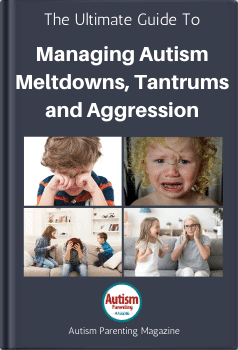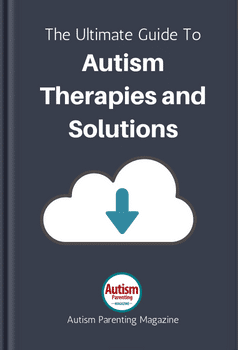For these on the spectrum, on a regular basis life can really feel overwhelming. The unstated guidelines, loud noises, and fixed strain usually result in autistic meltdowns in adults. They aren’t mood tantrums or emotional outbursts, however neurological overloads that occur when the mind is pushed previous its restrict.
Understanding what meltdowns are and the way to answer them could make all of the distinction within the lives of autistic people.

Obtain your FREE information on
Managing Autism Meltdowns, Tantrums and Aggression
What’s an autistic meltdown in adults?
An autistic meltdown in adults is a whole lack of management triggered by overwhelming stress, sensory enter, or emotional overload. It’s the mind’s manner of claiming, “I can’t cope proper now.” It’s an intense feeling that shuts the whole lot else down.
In autistic people, meltdowns usually don’t seem like individuals count on. Some are loud, with yelling, crying, or pacing. Others are quiet, with shutdowns, withdrawal, or dissociation. Each are legitimate.
Adults are inclined to masks these experiences. Many carry disgrace. That makes autistic meltdowns tougher to acknowledge, and even tougher to speak about.
One of the damaging myths? Believing that meltdowns are simply mood tantrums.
Autism tantrums vs. meltdowns in adults
Meltdowns happen when a person is flooded with overwhelming emotions that they’ll not regulate.
Tantrums are goal-driven. They’re meant to vary an end result. Suppose of a kid crying to get a sweet bar or yelling to win an argument.
Tantrums usually cease if the objective is met or ignored. They contain some stage of consciousness and management.
Autism meltdowns, then again, are involuntary reactions. They occur when somebody is totally overwhelmed and may not handle their feelings, sensory enter, or setting.
Right here’s the distinction between meltdowns and tantrums in adults:
- A tantrum would possibly contain checking to see who’s watching.
- A meltdown would possibly contain sobbing, stimming, or shutting down, with no management over the response.
Bodily indicators could embrace shaking, tensing the complete physique, or intense crying. Facial expressions could also be clean or present panic.
No quantity of logic or self-discipline can “snap them out of it.” This isn’t about conduct. It’s a bodily response, the nervous system going offline.
To an autistic particular person, this isn’t drama. It’s survival. And too usually, it’s misunderstood.
What causes meltdowns in adults?
Many issues can result in an autism meltdown. Usually, it’s not only one set off. It’s a quiet buildup over time, like a snowball rolling downhill.
Causes embrace frequent triggers equivalent to:
- Sensory overload: Vivid lights, robust smells, scratchy garments, or an excessive amount of background noise can fry the sensory programs.
- Social strain: Pretending to be “regular,” masking throughout social interactions, forcing eye contact, and following hidden guidelines takes a heavy toll.
- Emotional suppression: Pushing down emotions to keep away from battle or disgrace solely delays the explosion.
- Government dysfunction: A shock schedule change or too many selections can throw the whole lot off.
- Miscommunication: Being misunderstood, particularly when making an attempt your finest, can really feel devastating.
Anxious stimuli construct till the autistic particular person experiences a tipping level. Every set off provides weight. With out entry to a quiet house, the mind can’t carry it anymore.
An autistic particular person usually experiences this after making an attempt to remain regulated for much too lengthy.
Even one thing “easy” can push an autistic particular person previous their restrict. This usually consists of surprising change, sensory overload, and overwhelming conditions. When the emotional backpack is full, yet one more factor is an excessive amount of.
It’s not all the time the large occasions that trigger sensory overload for an autistic particular person. Generally it’s the buildup of small, repeated nerve-racking stimuli. These can embrace the hum of fluorescent lights, background chatter, or the social strain to seem “positive.”
What do autistic meltdowns seem like in adults?
There isn’t a single manner an autism meltdown reveals up. Each autistic particular person experiences it otherwise.
Nonetheless, there are early warning indicators to search for (together with indicators of an autistic shutdown):
- Yelling, crying, or an intense response like an emotional outburst
- Pacing, intense stimming, or repetitive actions
- Leaving a scenario abruptly
- Going silent, avoiding eye contact, or changing into nonverbal
- Self-injuring or self-harming
However right here’s the half individuals miss: autistic meltdowns aren’t all the time loud. Generally, they’re silent. Somebody could look “positive” on the surface however really feel like they’re falling aside inside.
These invisible meltdowns are simply as actual. Simply as painful. Simply as legitimate.
Think about you’re in a crowded grocery retailer. The lights are harsh, a cart bumps into you, and a child is crying close by. It’s onerous to focus. Your chest tightens, your physique freezes, and all you wish to do is disappear. That’s a meltdown, too.
For an autistic particular person, it’s not over when the second passes. There’s usually a wave of guilt, exhaustion, disgrace, or perhaps a psychological well being disaster that follows an autism meltdown.
Individuals could expertise regret after what appears like a lack of management in entrance of others. That is very true if a member of the family or peer witnessed the entire meltdown.
Indicators of an autistic meltdown in adults
Recognizing the warning indicators of autistic meltdowns is essential. The earlier we discover them, the earlier we will supply assist.
Listed below are some frequent indicators of autism meltdowns in adults to look at for:
- Elevated irritability or sensory sensitivity
- Modifications in speech (quantity, tone, or tempo)
- Avoiding eye contact or pulling away from dialog
- Stimming that turns into quicker or extra intense
- Masking ears, closing eyes, or holding their head
- Stepping again from a bunch or shifting to a quiet spot
- Sudden silence or going nonverbal attributable to feeling overwhelmed
- Tense posture, clenched fists, or frozen physique language
These indicators might be refined and linked to potential triggers. Many autistic individuals attempt to push via or cover them, particularly in public.
However these early alerts matter. Noticing them means we may help keep away from meltdowns.
It’s additionally a manner for autistic individuals to reclaim management. It permits them to study their very own indicators and provides themselves permission to pause.
Autistic meltdowns in feminine adults
Autistic meltdowns in females are sometimes missed. They don’t all the time seem like what individuals would count on. That is primarily as a result of most girls are raised to masks the signs.
From a younger age, ladies are taught to be “good,” “quiet,” and “simple to get together with.” Many autistic girls study to carry it in till they’re alone.

They could:
- Cry in a rest room or a automobile
- Shut down as an alternative of yelling
- Discuss an excessive amount of or over-apologize to cover discomfort
- Disassociate whereas smiling at a social occasion
These meltdowns usually occur in non-public, generally presenting as an autistic shutdown. That doesn’t make them much less legitimate or much less painful.
As a result of they keep hidden, many autistic girls are misdiagnosed or missed fully. Over time, that may result in exhaustion, anxiousness, and autistic burnout.
When an autistic particular person is chronically misunderstood, the emotional toll usually turns into a quiet disaster.
In feminine autistic adults, meltdowns may seem as perfectionism or obsessive inside self-talk. These internalized reactions nonetheless mirror the overwhelming misery, even when they seem “purposeful” on the surface.
Managing grownup autistic meltdowns
Managing meltdowns begins with understanding, not management. Assist ought to calm the nervous system, not problem it.
Most analysis focuses on autistic youngsters. Nevertheless, lots of the similar methods work for adults when tailored thoughtfully.
These methods may help autistic adults handle meltdowns and get better after one happens.
Self-regulation methods
The next coping methods assist emotional regulation. They are often useful earlier than, throughout, or after a meltdown:
- Weighted blankets or compression gear: These may help calm the nervous system.
- Noise-canceling headphones: Use them in busy shops or loud ready rooms to cut back stress and filter out sound.
- Music as a instrument: Use calming music to decrease stress response.
- Stimming as a regulation instrument: Rocking, pacing, or fidgeting may help launch emotional strain.
- Scheduled decompression time: Taking quiet breaks prevents overload.
- Decrease overwhelm: Cut back particular sensory triggers like vivid lights or tough textures.
Each autistic particular person deserves entry to instruments that assist them really feel protected and regular in a chaotic world.
Assist from others
The next are methods family members may help with out overwhelming the particular person:
- Don’t ask questions throughout an autism meltdown: Even “Are you okay?” can add strain. Keep calm and current. Phrases can wait.
- Respect house: If the particular person walks away, allow them to. Solely step in if security is in danger.
- Supply grounding instruments: You’ll be able to hand them a gentle object, a water bottle, sensory instruments, or one thing chilly. No phrases are wanted.
- Supply aftercare: When it ends, supply quiet time or a quiet house. Acknowledge the hassle it took to get via it. Restoration issues.
It’s not about “fixing” an autistic particular person. It’s about creating an area the place they really feel protected sufficient to get better.
Supporters also needs to concentrate on their very own reactions. In the event you panic, autistic people could feed off this. Having a relaxed presence is commonly extra highly effective than phrases.
Therapies and instruments that assist long-term
The next approaches may help construct important coping expertise and scale back the frequency or depth of future autistic meltdowns:
- CBT tailored for autistic individuals: Focuses on emotional understanding and pondering patterns. It have to be modified for neurodivergent wants.
- Occupational remedy: Can enhance sensory regulation and each day life expertise. It helps individuals determine what triggers them.
- Emotion regulation teaching: Builds consciousness of inside alerts and teaches easy methods to navigate overwhelming conditions in each day duties.
- Autistic-led peer assist: Being round individuals who perceive reduces disgrace. It creates house for progress and therapeutic.

Obtain your FREE information on
Autism Therapies and Options
Some autistic people profit from structured routines, visible aids, or sensory-friendly environments to stop meltdowns.
By serving to somebody determine triggers, we empower them to develop methods for emotional and sensory stability.
Assist doesn’t imply management. It means being current in a protected setting. Supply sensory instruments and a quiet house. That’s how autistic individuals decompress, get better, and thrive.
Understanding results in higher assist
An autism meltdown in adults shouldn’t be an indication of weak spot, defiance, or failure. They’re neurological responses to a system pushed past its limits.
By recognizing the indicators, understanding the causes, and responding with empathy, we create safer areas for autistic adults to be themselves.
Assist doesn’t must be difficult. It must be variety. It must be knowledgeable.
After we shift from management to connection, the whole lot modifications.
Autistic adults deserve compassion, not correction. And with the correct instruments and consciousness, assist turns into potential.
FAQs
Q: What are the phases of an autistic meltdown?
A: Autistic meltdowns usually happen in three phases. The primary is the build-up section, when indicators of misery start to floor. Subsequent comes the meltdown itself, when the nervous system shuts down. Lastly, there’s the restoration section. This stage is commonly quiet and withdrawn, however simply as necessary.
Q: How do you cope with grownup autistic meltdowns?
A: You don’t attempt to cease or repair an autistic meltdown; you assist the particular person via it. Supply house in the event that they want it. Cut back sensory enter as a lot as potential. Keep away from asking questions or giving directions. Keep calm, regular, and current.
Q: What does autistic burnout seem like in adults?
A: Autistic burnout can seem like excessive tiredness that doesn’t go away with relaxation. Adults could wrestle to do issues they used to deal with simply, like speaking, working, or socializing. They could really feel numb, overwhelmed, or have extra meltdowns than regular.
Q: Do autistic adults cry simply?
A: Some autistic adults cry simply. Others go silent or shut down. Crying shouldn’t be a weak spot. It’s a launch. Both manner, it’s the nervous system talking.
Q: Are meltdowns preventable?
A: Meltdowns will not be all the time preventable. Nevertheless, they’ll occur much less usually with routine, sensory assist, and individuals who reply with care, not management.
References
Lewis, L. F., & Stevens, Okay. (2023). The lived expertise of meltdowns for autistic adults. Autism, 27(6), 1817-1825. https://doi.org/10.1177/13623613221145783
Beck, Okay. B., MacKenzie, Okay. T., Kumar, T., Breitenfeldt, Okay. E., Chang, J. C., Conner, C. M., … & Mazefsky, C. A. (2024). “The World’s Actually Not Set Up for the Neurodivergent Individual”: Understanding Emotion Dysregulation from the Perspective of Autistic Adults. Autism in Maturity. https://www.liebertpub.com/doi/abs/10.1089/aut.2023.0214
Stevens, Okay. (2019). Lived Expertise of Shutdowns in Adults with Autism Spectrum Dysfunction. https://scholarworks.uvm.edu/src/2019/program/91/
Lachance, Okay. (2024), Managing the meltdown: Supporting autistic youth via episodes. The Brown College Little one and Adolescent Habits Letter, 40: 1-4. https://doi.org/10.1002/cbl.30763
